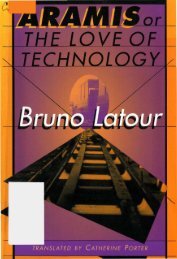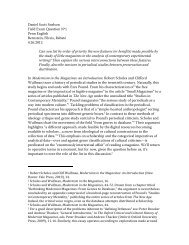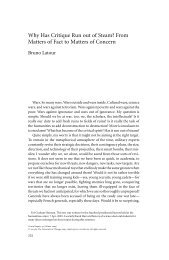The Exploit: A Theory of Networks - asounder
The Exploit: A Theory of Networks - asounder
The Exploit: A Theory of Networks - asounder
Create successful ePaper yourself
Turn your PDF publications into a flip-book with our unique Google optimized e-Paper software.
Nodes 51<br />
be it in the living cell, in a petri dish or test tube, or, more recently, in a<br />
computer.<br />
<strong>The</strong> widespread use <strong>of</strong> computer databases (GenBank), Web - based<br />
gene - finding algorithms (BLAST), and automated genome sequencing<br />
computers demonstrates the principle <strong>of</strong> base pair complementarity<br />
in silico, in addition to the in vitro and in vivo.<br />
In short, the increasing integration <strong>of</strong> cybernetics and biology has resulted<br />
in an informatic view <strong>of</strong> life that is also a view <strong>of</strong> life as a network (“biological<br />
control”).<br />
But it is when we see biotechnology in its instrumental, yet nonmedical,<br />
nonbiological context, that the “protocols” <strong>of</strong> biological control<br />
become the most evident. One such example is the nascent field<br />
<strong>of</strong> DNA computing, or biocomputing. 20<br />
<strong>The</strong> actual design and construction <strong>of</strong> a computer made <strong>of</strong> DNA takes<br />
these protocols or biological control into a whole new field <strong>of</strong> concern beyond<br />
the traditional distinctions <strong>of</strong> biology and technology.<br />
While DNA computing is so new that it has yet to find its “killer<br />
app,” it has been used in a range <strong>of</strong> contexts from cryptography to<br />
network routing or navigation problems to the handheld detection <strong>of</strong><br />
biowarfare agents. <strong>The</strong> techniques <strong>of</strong> DNA computing were developed<br />
in the mid - 1990s by Leonard Adleman as a pro<strong>of</strong> - <strong>of</strong> - concept<br />
experiment in computer science. 21 <strong>The</strong> concept is that the combinatorial<br />
possibilities inherent in DNA (not one but two sets <strong>of</strong> binary<br />
pairings in parallel, A - T, C - G) could be used to solve specific types<br />
<strong>of</strong> calculations. One famous one is the so - called traveling salesman<br />
problem (also more formally called a “directed Hamiltonian path”<br />
problem): imagine a salesman who must go through five cities. <strong>The</strong><br />
salesman can visit each city only once and cannot retrace his steps.<br />
What is the most efficient way to visit all five cities? In mathematical<br />
terms, the types <strong>of</strong> calculations are called “NP complete” problems,<br />
or “nonlinear polynomial” problems, because they involve a large









